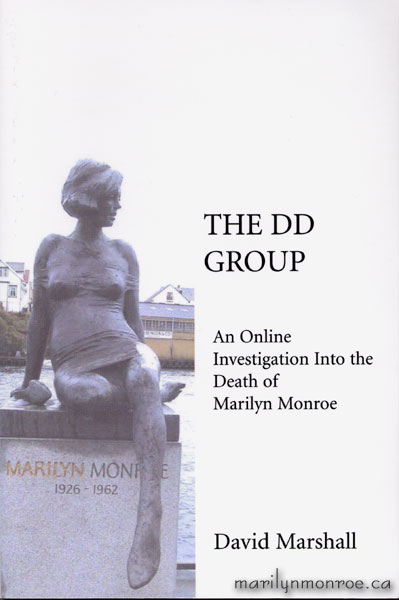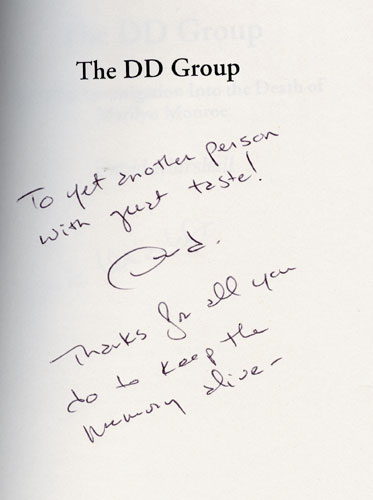 |
If you are interested in the circumstances surrounding Marilyn's death this is the book for you. It does not contain any photos but instead is an online discussion that goes through every detail of Marilyn's last day and the theories that have come forward over the years. |
||||||||||||||||||
|
|||||||||||||||||||
| |||||||||||||||||||
|
BOOK REVIEW BY DAVID MARSHALL This is NOT a review. Of course, I could
really take advantage of the situation and tell you that this book is so
essential that it is a MUST for any MM fan but then Iíd have to face you all
every dayÖ So instead of a review, what Iíd like to do is to just fill you
in on the book, why it was created and basically what sort of things you will
find inside. When I joined Forever Marilyn in
September 2002, it was a whole new world to me. This was the first online group
I had belonged to and it was a thrill to find a whole group of people who shared
my opinion of Marilyn Monroe. Then after about a month in the group, I brought
up the topic of her death. And that set off a firestorm of messages with what
seemed like every member sending in their opinions on what took place at the end
of a small cul-de-sac in Brentwood all those years before. In fact, the topic of
Marilynís passing generated such a huge volume of email that it soon became
apparent to Crystal and Jill that a new and separate group should be created to
focus entirely on the topic. That was the birth of ìFMís
Death Discussion Groupî, or ìThe DD Groupî as it soon became known as.
While the group had a membership of 90 to 100 members, there were about six
individuals who posted on a daily basis and carried the conversation. This core
group spent every day from October 2002 to October 2003 discussing the case,
sharing research, uncovering new information and slowly working its way through
the myriad of conflicting witness statements and author opinions. From the very beginning, the
information coming into the group and the well-written and intelligent posts
impressed me. Enough so that I began to save many of the messages and slowly
built up a history in our Files Section of what topics had been covered and how
our discussion progressed. By October 2003 as the discussion wound down, it
dawned on me that we had covered so much ground and had put to rest so many
falsehoods, that it was a shame that others who would be interested in the topic
but had missed the initial discussion couldnít read about it. So I thought,
why not-- why not create a book from all the files I had saved, all the
information we had covered and tie it altogether with a sort of on-going
narration? That was the genus of what became ìThe DD Groupî. When the group was initially
formed it was apparent that if we were to succeed, the discussion would require
some form of structure. Without some kind of framework to hold the discussion in
place and keep it moving forward, I was afraid that we would be forever going
off track and never accomplishing much of anything. The structure I arrived at
was not only the tool that allowed us to keep moving forward but reflected the
need for the group to begin with. The need for the group was due to
the fact that nearly every book covering Marilynís life, (and especially when
it came to the events of the summer of 9162), present not only conflicting
accounts of what took place but completely contradictory statements of matters
as simple as what and where Marilyn ate the night before her death. For example: Some books have it that Marilyn
and Pat ate alone at La Scala on August 3, 1962. Others have it that Marilyn and
Pat were joined by Peter Lawford. Still others have it that it was a private
dinner with Marilyn and Robert Kennedy alone. Then the owner of La Scala is
quoted in some accounts that he brought dinner from the restaurant directly to
Marilynís home. Or take something as simple as breakfast that Saturday
morning. If you compare the various books, Marilyn either had a single glass of
grapefruit juice, ate an omelet prepared by Mrs. Murray, had hamburgers for
lunch or ate absolutely nothing at all. I mean, if we can not decide what the
woman had for breakfast, how can we possibly expect to figure out how she died? As to the cause of death itself,
the same confusion comes up. Suicide? Accidental overdose? Suffocated with a
pillow? Hot shot? Jimmy Hoffa? RFK? CIA? Medical error? Killed to bring about
the downfall of JFK? Killed under instructions by the President? Or was it
really true that sheíd been silenced because she had learned via pillow talk
with JFK that there actually were space aliens being held at Area 51? The list of conflicting accounts
covers every minute of that last day. Did Jeanne Carmen really call her that
night? Did Jose Bolanos actually hear an altercation at her door while he waited
on the phone? Or forget about who called her or who saw her last-- when was the
death actually discovered? 10:00? Midnight? 3:30? The list of misinformation and
contrasting reports just go on and on and on, leaving every person interested in
the demise of one of the greatest figures of the 20th century more
confused than when they were before they started reading. So the group began its discussion
with the simple structure of comparing all of the written accounts of
Marilynís last day one time segment at a time. Beginning at 8:00 Saturday
morning, August 4, 1962 and ending at approximately 10:00 Sunday morning with
the completion of the autopsy, the group would review each time period and then
discuss what likely took place. Our criteria was not only logic but the veracity
of the documentation, checking the sources listed in the books as well as
studying any personal or political agendas of the various authors or witnesses.
As for materials used, the group was able to utilize not only the well known
biographies but obscure material from such authors as William Fowler, (who
discusses his relationship with Robert Slatzer), medical and psychology
textbooks, vintage magazine and newspaper accounts, Kennedy biographies, (both
pro and anti-Kennedy), unseen police reports and handwritten notes taken by
police investigators when interviewing such key figures as Eunice Murray. When
it came time to write the book I found that we had a bibliography covering more
than 75 books and documentaries. In addition to the events leading up to August
4, 1962, the book also covers the aftermath-- Marilynís funeral and the
post-Marilyn lives of key figures such as Dr. Greenson, Mrs. Murray and Pat
Newcomb. What ìThe DD Group: An Online
Investigation into the Death of Marilyn Monroeî will hopefully provide the
reader is enough material to not only feel that they are a part of the
discussion as it happened but enough information to reach their own conclusions.
By slowly dissecting all of the available material, by weeding through the
conflicting accounts, by studying each witness statement carefully, I really do
believe that the book is the closest we will ever come, (save an official
investigation with sworn testimony), to understanding the events of August 4,
1962. Rather than ìtellî you what happened, (because really, just like all
of the others who have written abut these events, I was not there), I allow the
information to be discussed and sifted through. The closest I can describe the
experience as being would be as if an official inquiry had taken place and the
reader, just like the members of the group, are jurors. We sit back and listen
to the presented testimony and come to our own conclusions. And just like a jury, while some
members might believe one witness and others another, the group did not come to
a united decision. But the book, just like the group, provides all of the
information, works through every hour of that last day, (and many events of that
last summer that led up to that final weekend), so that by the end the reader
should be able to sit back and come to an educated, documented opinion of what
brought about the death of a woman whose memory deserves no less. |
|||||||||||||||||||

